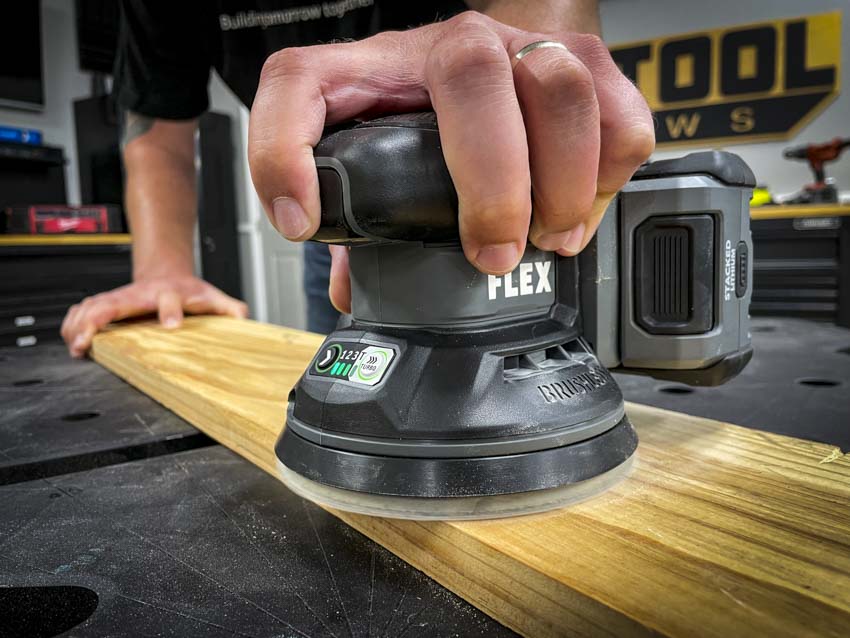What is an Orbital Sander?
An orbital sander is a power tool designed for sanding and smoothing various surfaces, primarily wood, but also applicable to other materials like metal, plastic, and drywall. It derives its name from the unique orbital motion pattern of the sanding pad, which combines small circular motions with a larger orbital rotation.
This dual-action movement helps to prevent the formation of deep scratches and swirl marks, resulting in a smoother and more uniform finish compared to traditional sanding methods. Orbital sanders are particularly effective at removing material quickly while leaving a fine, swirl-free surface, making them a popular choice for woodworking projects, furniture refinishing, and surface preparation tasks.
There are two main types of orbital sanders: random orbit sanders and sheet orbital sanders. Random orbit sanders feature a round sanding pad that moves in a random, orbital pattern, making them ideal for general sanding tasks and removing material evenly. Sheet orbital sanders, on the other hand, utilize a rectangular sanding sheet that oscillates in an orbital motion, making them well-suited for sanding larger, flat surfaces and corners.
The working principle of an orbital sander involves a motor that powers the sanding pad or sheet, allowing it to spin and orbit simultaneously. This dual motion helps to distribute the sanding action evenly across the surface, preventing the formation of grooves or deep scratches that can occur with traditional sanding methods. The sanding pad or sheet is typically covered with an abrasive material, such as sandpaper or sanding discs, which can be easily replaced as needed.
Table of Contents
Benefits of Using an Orbital Sander
An orbital sander is a powerful and versatile tool that offers several benefits over traditional sanding methods. One of the primary advantages is its ability to produce a smooth, swirl-free finish on various surfaces, including wood, metal, and plastic. The random orbital motion of the sanding pad mimics the motion of hand sanding, but with greater efficiency and consistency.
Efficiency is another significant benefit of using an orbital sander. The tool’s circular motion and oscillating action allow for faster material removal compared to manual sanding. This increased efficiency translates into time savings, making it an ideal choice for larger projects or when working with harder materials that require more aggressive sanding.
Versatility is a standout feature of orbital sanders. These tools can handle a wide range of sanding tasks, from rough material removal to fine finishing work. By simply changing the grit of the sanding paper, an orbital sander can adapt to different stages of the sanding process, eliminating the need for multiple specialized tools.
Time-saving is a crucial advantage, especially in professional settings or when working on multiple projects simultaneously. Orbital sanders significantly reduce the time and effort required for sanding tasks, allowing users to complete projects more quickly and move on to the next task. This increased productivity can lead to cost savings and improved workflow efficiency.
Types of Orbital Sanders
There are several types of orbital sanders, each designed for specific tasks and materials. The most common types include:
Random Orbit Sanders
Random orbit sanders are versatile tools that combine orbital and rotating motions, creating a random sanding pattern that prevents swirl marks and leaves a smooth finish. They are suitable for various materials, including wood, metal, and plastic, and are commonly used for finishing and polishing tasks.
Sheet Sanders
Sheet sanders, also known as finishing sanders, use a rectangular sanding pad that oscillates back and forth. They are ideal for sanding large, flat surfaces, such as tabletops, floors, and walls. Sheet sanders are often used for final finishing touches or for removing minor imperfections.
Eccentric Sanders
Eccentric sanders, sometimes called eccentric orbit sanders, have a unique sanding motion that combines rotation and eccentric (off-center) orbiting. This motion creates a more aggressive sanding action, making eccentric sanders suitable for removing material quickly and tackling tough jobs, such as stripping paint or smoothing rough surfaces.
Palm Sanders
Palm sanders, also known as quarter-sheet sanders, are compact and lightweight, designed for one-handed operation. They are perfect for sanding in tight spaces, corners, and hard-to-reach areas. Palm sanders are often used for detail work, such as sanding trim, cabinets, or furniture.
Each type of orbital sander has its strengths and weaknesses, so it’s important to choose the right tool for the job at hand. Factors to consider include the size of the project, the material being sanded, and the desired finish.
Choosing the Right Orbital Sander
Selecting the appropriate orbital sander is crucial for achieving optimal results and ensuring a smooth, efficient sanding experience. Here are some key factors to consider when choosing the right orbital sander:
Size: Orbital sanders come in various sizes, ranging from compact palm sanders to larger models. Consider the size of the projects you’ll be working on and the surface area you need to cover. Smaller sanders are ideal for detail work and tight spaces, while larger sanders are better suited for expansive surfaces.
Power: The power of an orbital sander is typically measured in amps or watts. More powerful sanders are better equipped to handle tougher materials and remove material more quickly. However, they can also be more challenging to control and may cause excessive vibration. Match the power to the types of materials you’ll be sanding and your desired level of aggressiveness.
Speed: Orbital sanders offer variable speed settings, allowing you to adjust the sanding speed to suit different materials and applications. Higher speeds are suitable for aggressive material removal, while lower speeds are better for finer finishing work and delicate surfaces.
Dust Collection: Efficient dust collection is essential for maintaining a clean work environment and prolonging the life of your sander. Look for orbital sanders with integrated dust collection systems or compatibility with vacuum attachments. This feature not only keeps your workspace tidy but also helps prevent clogging and premature wear on the sanding pad.
Ergonomics: Comfort and control are key when using an orbital sander, especially for extended periods. Consider factors such as weight distribution, grip design, and vibration dampening. Ergonomic features like rubberized handles, palm grips, and low-vibration technology can help reduce fatigue and improve control during use.
By carefully evaluating these factors, you can select an orbital sander that meets your specific needs, ensuring optimal performance, efficiency, and user comfort throughout your sanding projects.
Sanding Techniques and Best Practices
Proper sanding techniques are essential for achieving a smooth, flawless finish with an orbital sander. Here are some best practices to follow:
Preparing the Surface: Before sanding, ensure the surface is clean and free of debris, dust, or any loose material. This will prevent scratches and ensure an even finish. If working on a previously painted or varnished surface, it’s recommended to use a coarse grit sandpaper to remove the existing coating first.
Sanding Patterns: When using an orbital sander, it’s important to move the tool in a consistent pattern, overlapping each pass by about 50%. This ensures even sanding and prevents missed spots. Start with the sander off the surface, and then gently lower it onto the workpiece. Move the sander in a back-and-forth or circular motion, avoiding excessive pressure or dwelling in one area for too long.
Grit Progression: Begin with a coarse grit sandpaper (e.g., 60-80 grit) to remove significant material or level out uneven surfaces. Progressively move to finer grits (100, 120, 150, and so on) until achieving the desired smoothness. Each successive grit should remove the scratches left by the previous one, resulting in a finer finish.
Avoiding Swirl Marks: Swirl marks are circular patterns left on the surface by the sander’s orbital motion. To minimize swirl marks, use a high-quality sandpaper designed for orbital sanders, and avoid excessive pressure or dwelling in one area. Additionally, sand in a consistent pattern, and use the appropriate grit progression to gradually refine the surface.
Remember, proper sanding techniques take practice, patience, and attention to detail. Always follow safety guidelines, wear appropriate personal protective equipment (PPE), and keep the work area well-ventilated when using an orbital sander.
Using an Orbital Sander on Different Materials
Wood: Orbital sanders are ideal for sanding wood surfaces, whether it’s preparing raw wood for finishing or removing an existing finish. For rough sanding, start with a coarse grit (60-80) and work your way up to finer grits (120-220) for a smooth finish. Be mindful of the wood grain and sand in the direction of the grain to avoid scratches.
Metal: While orbital sanders can be used on metal, it’s essential to use the right type of abrasive. Aluminum oxide or zirconia abrasives are recommended for sanding metal, as they are harder and more durable than traditional sandpaper. Start with a coarse grit and work your way up to a finer grit for a polished finish.
Plastic: Orbital sanders can effectively sand and smooth plastic surfaces, but caution is advised. Use a finer grit (120 or higher) and apply light pressure to avoid generating too much heat, which can melt or deform the plastic. Plastic-specific abrasives may also be used for better results.
Drywall: Orbital sanders are handy for sanding drywall joints and surfaces after mudding or patching. Use a coarse grit (80-100) to remove excess joint compound and a finer grit (120-150) for a smooth finish. Vacuum frequently to prevent clogging and ensure an even surface.
Paint Removal: Orbital sanders can be used for removing paint from various surfaces, including wood, metal, and drywall. Start with a coarse grit (36-60) and gradually move to finer grits as the paint is removed. Be cautious when sanding lead-based paints, as the dust can be hazardous. Always work in a well-ventilated area and use appropriate personal protective equipment.
Maintenance and Care
Proper maintenance and care are essential to ensure your orbital sander operates at peak performance and has a long lifespan. Here are some key considerations:
Cleaning: Regularly clean your orbital sander to remove dust and debris buildup. Use a brush or compressed air to clear the vents and motor housing. Wipe down the sander body with a damp cloth, taking care not to let moisture enter the motor or electrical components.
Replacing Sandpaper: Sandpaper wears down over time and needs to be replaced regularly. Replace the sandpaper when it becomes clogged or worn, as using worn sandpaper can damage the surface you’re working on and reduce the sander’s efficiency. Follow the manufacturer’s instructions for properly attaching and securing new sandpaper.
Lubrication: Most orbital sanders have ball-bearing construction, which requires periodic lubrication. Refer to your owner’s manual for the recommended lubricant type and frequency. Proper lubrication ensures smooth operation and extends the life of the bearings.
Storage: When not in use, store your orbital sander in a dry, clean environment, away from direct sunlight and extreme temperatures. Proper storage helps prevent rust, corrosion, and other damage. Consider storing the sander in a carrying case or box to protect it from dust and debris.
By following these maintenance and care guidelines, you can ensure your orbital sander operates smoothly, efficiently, and safely for years to come.
Safety Considerations
Orbital sanders are powerful tools that require proper safety precautions. Dust control is crucial when using an orbital sander, as the sanding process generates a significant amount of fine particulate matter. Inhaling this dust can be harmful to your respiratory system. It’s essential to use a vacuum attachment or dust collection system to capture the dust at the source. Additionally, wearing a respirator or dust mask can provide an extra layer of protection against airborne particles.
Protective gear is also essential when operating an orbital sander. Safety glasses or goggles should be worn to shield your eyes from any flying debris or dust particles. Hearing protection, such as earplugs or earmuffs, is recommended, as orbital sanders can produce loud noise levels. Wearing sturdy work gloves can help prevent abrasions and improve your grip on the tool.
Electrical safety is another critical aspect to consider when using an orbital sander. Always inspect the power cord for any signs of damage or fraying before use. Avoid using the sander in damp or wet environments, as water and electricity can be a dangerous combination. If you need to use an extension cord, ensure it is rated for the amperage requirements of the sander and is in good condition.
It’s also important to maintain a stable and secure stance when operating an orbital sander. Avoid overreaching or applying excessive pressure, as this can cause you to lose control of the tool. Always unplug the sander when making adjustments, changing sandpaper, or performing maintenance to prevent accidental startup.
By following these safety guidelines and using common sense, you can minimize the risks associated with orbital sanders and ensure a safe and efficient sanding experience.
Orbital Sanders vs. Other Sanding Tools
Orbital sanders are a versatile and efficient sanding tool, but they are not the only option available. Depending on the project and the desired results, other sanding tools may be more suitable. Here’s a comparison of orbital sanders with some of the most common alternatives:
Belt Sanders
Belt sanders are powerful tools that use a continuous loop of abrasive material to remove material quickly. They are ideal for heavy-duty sanding tasks, such as removing thick layers of paint or smoothing rough surfaces. However, belt sanders can be more aggressive and challenging to control, making them less suitable for delicate or intricate work.
Palm Sanders
Palm sanders, also known as quarter-sheet sanders, are compact and lightweight, making them easy to maneuver and control. They are often used for smaller projects or for sanding in tight spaces. While palm sanders are less aggressive than orbital sanders, they may require more effort and time to cover larger surfaces.
Oscillating Sanders
Oscillating sanders are a versatile option that can handle a variety of sanding tasks. They use a back-and-forth motion to sand surfaces, which can be especially useful for getting into corners and tight spaces. However, oscillating sanders may not be as efficient as orbital sanders for larger, flat surfaces, and they can leave swirl marks if not used properly.
While each sanding tool has its strengths and weaknesses, orbital sanders strike a balance between power and control. They are suitable for a wide range of projects, from furniture refinishing to woodworking and automotive work. With their random orbital motion, orbital sanders provide a smooth, swirl-free finish while still removing material efficiently. Additionally, many orbital sanders feature dust collection systems, which help to keep the work area clean and reduce the amount of airborne dust.
Top Orbital Sander Brands and Models
When it comes to orbital sanders, there are several reputable brands that consistently deliver high-quality products. Here are some of the top brands and recommended models to consider:
Bosch
Bosch is a leading manufacturer of power tools, known for their durability and performance. Their orbital sanders are no exception. The Bosch ROS20VSC Palm Router Tool is a popular choice, offering a compact design and variable speed control for versatile sanding tasks.
Makita
Makita is another trusted name in the power tool industry, and their orbital sanders are highly regarded. The Makita BO5041K is a reliable option, featuring a powerful 3.0 amp motor and a large sanding pad for efficient material removal.
DeWalt
DeWalt is renowned for their rugged and long-lasting tools, and their orbital sanders live up to this reputation. The DeWalt DWE6423K is a great choice, with a low-profile design for improved maneuverability and a dust-sealed switch for added durability.
Porter-Cable
Porter-Cable offers affordable yet high-performing orbital sanders. The Porter-Cable 382 is a budget-friendly option that doesn’t compromise on quality, with a 2.0 amp motor and a dual-plane oscillation for a smooth sanding experience.
When choosing an orbital sander, consider features like variable speed control, dust collection systems, and ergonomic designs for comfortable extended use. Additionally, look for models with long power cords and easy access to replacement pads or accessories.



